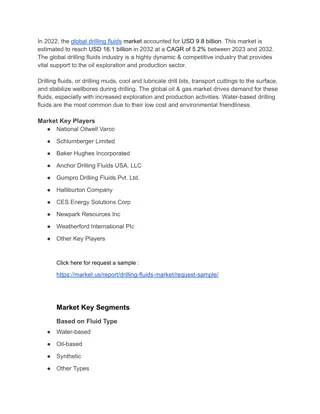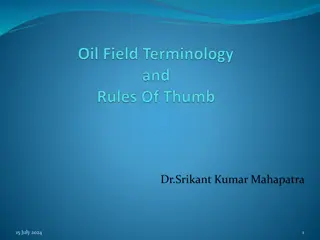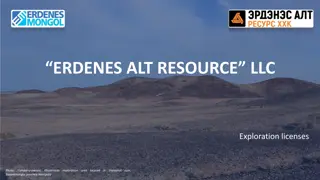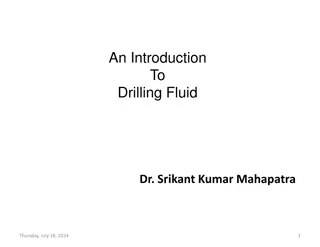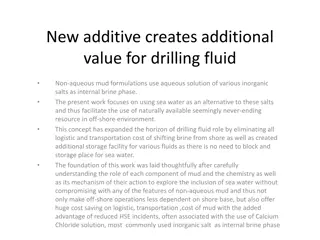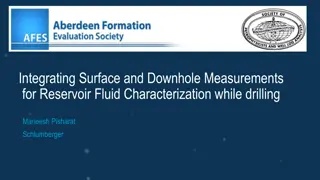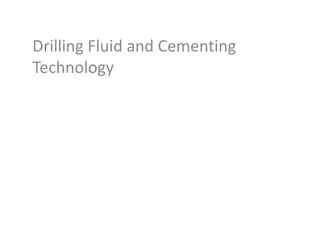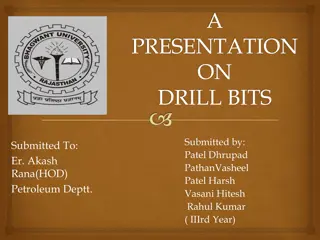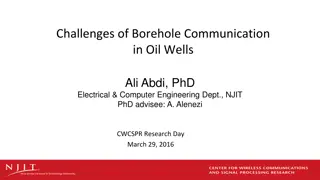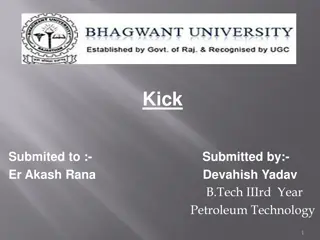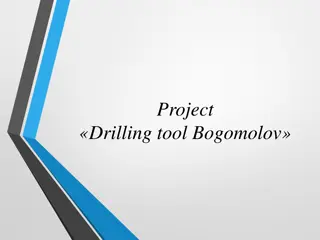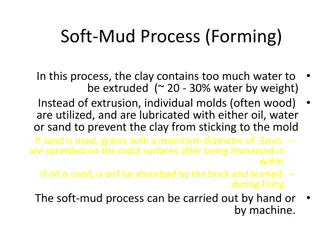Understanding Inhibited Mud Systems in Drilling Operations
Inhibited mud systems play a vital role in drilling operations by repressing clay hydration and dispersion, offering advantages like higher clay concentration tolerance, reduced effects of contaminants, and better control of mud weight and viscosity. These systems are categorized into different types such as lime mud, low lime mud, gypsum mud, sea water mud, and more, each with specific properties and benefits for efficient drilling processes.
Download Presentation

Please find below an Image/Link to download the presentation.
The content on the website is provided AS IS for your information and personal use only. It may not be sold, licensed, or shared on other websites without obtaining consent from the author. Download presentation by click this link. If you encounter any issues during the download, it is possible that the publisher has removed the file from their server.
E N D
Presentation Transcript
Dr. Srikant Kumar Mahapatra 13 July 2024 1
Basic systems are usually converted to complex system as a well deepened, as wellbore temperature and/or pressure increase and formation changes which require some additional additives. Some times more than one system is used in the same well. 13 July 2024 2
Application Geology Make up water Surface interval Intermediate interval Production interval Shale type Sand type(Permeability) Carbonate Salt Type of water Chloride concentration Hardness of water(Ca/Mg) 13 July 2024 3
Drilling Data Hole size Hole angle Temperature Pressure Limitations Surface capacity Mixing capacity Mud Pump Solid control equipment Contaminant Solid Salt Cement Acid Gas( CO2, H2S) 13 July 2024 4
COMPRESSED AIR FOAM CLEAR WATER MUD WATER BASE MUD OIL BASE MUD SYNTHETIC BASE MUD 13 July 2024 5
MUD SYSTEMS A. Fresh Water Muds B. Inhibited Muds C. Water Base Emulsion D. Oil Base & Synthetic Muds 13 July 2024 6
Fresh water Base Mud 1- Spud mud. 2- Low solids mud. 3- Lignite mud. 4- Lignite surfactant systems. 5- Lignosulfonate mud. 6- Lignite/ Lignosulfonate mud. 13 July 2024 7
Inhibited Mud (Is that mud which repress the hydration and subsequent dispersion of clay into the mud) 1-Lime mud. 2- Low lime mud. 3- Gypsum mud. 4- Sea water mud. 5- Saturated salt water mud. 6- K-plus mud. 7- KCl-Glycol Mud 13 July 2024 8
Inhibited Mud (continue) Advantages over conventional water base mud:- 1- will Telerate a higher concentration of clays before developing high viscosity, 2- less drastic effects by contaminants such as cement, anhydrite, .. 3- can be raised to a higher mud weights before developing excessive viscosity, 4- less progressive gelling tendency. 13 July 2024 9
Water Base Emulsion Mud ((Is that mud with oil & water being emulsified together)). Advantages over conventional water base mud:- 1- Reduction of pipe torque & drag. 2- Increased ROP & bit life. 3- Reduction of bit balling. 4- Alleviation of differential sticking. 5- Better filtration control & production zone. 13 July 2024 10
Oil Base & Synthetic Mud ((Is that mud with oil as its continuous phase with not more than 1 5% water)). Advantages of oil base mud:- 1- protection of production horizon, 2- drill water sensitive formations; salt, clays.. 3- allowing longer bit runs than water base mud of the same weight. 4- less viscosity problems in deep hot holes. 13 July 2024 11
The following designations are normally used to classify water-base drilling fluid systems: 1. Nondispersed-noninhibited systems: spud muds, polymer/bentonite muds, extended bentonite muds ) 2. Nondispersed-inhibited systems: salt muds, KCL-polymer muds 3. Dispersed-noninhibited systems: lignite-lignosulfonate muds, phosphate-bentonite muds 4. Dispersed-inhibited systems: lime muds, gyp-lignosulfonate muds, seawater-prehydrated bentonite muds. 13 July 2024 12
The noninhibited-nondispersed fluids do not contain inhibiting ions such as chloride (Cl), calcium (Ca2+), or potassium (K+) in the continuous phase and do not utilize chemical thinners or dispersants to effect flow control. Nondispersed-inhibited fluids do contain inhibiting ions, but do not utilize chemical thinners or dispersants. Dispersed-noninhibited fluids utilize chemical thinners or dispersants, but do not contain inhibiting ions. Dispersed-inhibited fluids contain both chemical dispersants and inhibiting ions. When referring to a water-base mud system, the term nondispersed means that clay is free to find its own hydrous dispersed equilibrium in the aqueous solution. It also means that chemical acceleratives or dispersants have not been added to the system. The term noninhibited refers to the lack of specific ions such as potassium, calcium, or chloride that would inhibit the ability of the formation to absorb water. 13 July 2024 13
Spud Muds are used during drilling to: 1. clean the hole; 2. prevent sloughing of the surface hole; 3. provide a viscous sweep to clean gravel/sand from the borehole; and 4. form a filter cake to prevent seepage to the formation. Formulation: Water: (Fresh, brackish, salt) Caustic: 8.5 to 10.5 pH in fresh-water muds 10.5 to 11.5 pH in salt-water muds Clay: 10 to 35 lb/bbl, depending on mud weight Fresh water-Sodium bentonite. Salt water- Attapulgite or prehydrated bentonite 13 July 2024 14
Polymer/bentonite systems are used primarily in areas where the formations to be drilled contain low reactive solids. The systems can tolerate low concentrations of calcium. Water containing calcium in excess of 100 mg/L (ppm) should be pretreated with bicarbonate of soda to precipitate the calcium. Formulation: Water (Fresh, salty, light calcium) Sodium bentonite: 10 lb/bbl Polymer: CMC (low viscosity): 0.5 to 1.5 lb/bbl PAC (low viscosity): 0.5 to 1.5 lb/bbl Corn or potato starch: 2.0 to 4.0 lb/bbl 13 July 2024 15
Extended bentonite systems contain chemicals that extend the yield of bentonite and impart the desired properties to the mud while maintaining minimum solids content, which in turn improves penetration rates. Formulation: Water: (Treat out calcium with soda ash) Bentonite: 10 to 15 lb/bbl Polymers: Polyacrylate: .04 percent by volume ( if the system is weighted, more is required) Polyacrylamide: 0.5 to 3.0 lb/bbl Depending on the application, there are many other chemicals that can be used to impart viscosity and filtration control, such as polyanionic cellulose, xanthum gum, and potato or corn starch. 13 July 2024 16
The systems described below are classified as Nondispersed-Inhibited because prehydrated sodium bentonite finds its own equilibrium. Chemical dispersants (thinners) are not added to the systems. Included in these systems are certain muds containing salt ions (NaCl and KCl) that inhibit drilled formation solids from swelling and breaking into smaller particles as they are transported to the surface. This makes it easier for the solids-control equipment to remove these particles. 13 July 2024 17
Salt muds are used to improve borehole stability through the inhibiting effects of the salt(s) present in the makeup water, to minimize hole washout, and to prevent drilled solids from disintegrating as they are transported to the surface. Formulation: 1.Seawater or natural brine 2.Caustic soda: pH 9.0, by meter 3.Attapulgite: 10 to 20 lb/bbl 4.Potato or corn starch: 0.5 to 5.0 lb/bbl 5.Polymer: 0.25 to 1.25 lb/bbl (Polyanionic cellulose, CMC, xanthum gum, guar gum) Attapulgite does not contribute to filtration control; instead, polymers and/or starches must be used for this purpose. 13 July 2024 18
Saturated salt muds are used to prevent solution cavities from occurring in salt domes and stringers when they are penetrated by the bit, and to minimize hole washout in salt or carbonate beds. Formulation: Saturated salt water: 189,500 mg/L NaCl Attapulgite: 10 to 25 lb/bbl Potato or corn starch: 0.5 to 2.5 lb/bbl Polymer: 0.25 to 1.5 lb/bbl (Polyanionic cellulose, xanthum gum) 13 July 2024 19
Potassium chloride (KCl)-polymer muds inhibit clay swelling in thin, moderately active clay formations. A low percentage of K+ inhibits the swelling and disintegration of drilled solids, minimizes hole enlargement, and promotes borehole stability. Formulation: KCl water (5 to 15% K+ ion): l7.5 to 52.5 lb/bbl Caustic soda: Low pH (8.5) Prehydrated bentonite or attapulgite: 10 to 15 lb/bbl starch Polymer: 0.5 to 5.0 lb/bbl (Potato or corn starch, polyanionic cellulose, xanthum gum, guar gum) 13 July 2024 20
In general, inhibited systems have lower viscosities and low gel strengths. These fluids are used principally in the drilling of shales or clay formations. Formulation: 1.Water (Fresh or salty) 2.Sodium bentonite: Not to exceed 15 lb/bbl 3.Caustic soda: 11.5 pH 4.Lignite: 2 to 6 lb/bbl (used at breakover and not in highly weighted systems) 5.Lime: 2 to 3 lb/bbl excess in high-density fluids; 6 to 8 lb/bbl excess in low-density fluids 6. Lignosulfonate: 1 to 10 lb/bbl 7.Starch or polymers: 0.75 to 3.0 lb/bbl (Potato or corn starch, polyanionic cellulose, CMC) 13 July 2024 21
The primary advantage of a seawater-prehydrated bentonite system is the easy availability of it s source water. Another advantage is that the moderate amount of soluble salts in seawater inhibits the hydration and dispersion of clays. Formulation: 1.Seawater 2.Prehydrated sodium bentonite 3.Sodium bentonite: 30 to 50 lb/bbl 4.Lignosulfonate: 4 lb/bbl 5.Caustic soda: 10.5 to 11.5 pH 6.Lignite, starch or polymer: 0.25 to 6 lb/bbl 7.Defoamer 8.Aluminum stearate and nontoxic oil 13 July 2024 22
Developed to stabilize water sensitive shales by means of potassium ion inhibition. Minimize the hydration of shale , which minimize hole enlargement, bit and stabilizer balling, sloughing shale. Uses KCl as the primary source of potassium. About 3.5 to 5% KCl is used. PHPA is used as encapsulator 13 July 2024 23
Glycol is used to provide additional shale inhibition, wellbore stability, lubricity and good fluid loss. Cloud point glycol is used which form colloidal droplets at temperature above cloud point. Several glycols are available with wide range of cloud points. So, depending on the borehole temperature, proper type of glycol is used. 13 July 2024 24
It provides inhibition and hole stability as soluble silicate precipitate to form an insoluble silicate film in the hole to prevent water contact with shale and invasion into permeable formation. Silicate mud can be used at pH more than 11, as at pH below 11, silicate get precipitated 13 July 2024 25
Polyamines are used in high performance water based mud(HPWBM) for their ability to stabilize clay when drilling through water sensitive shales. Amines are amphoteric compound having both cationic and anionic charged sites on the molecular structure. The inhibition of clays is achieved by cationic exchange upon clay particles which contain negative charge. 13 July 2024 26
The most common base oils used have been diesel and kerosene. They have an acceptable viscosity, low flammability, and a low solvency for any rubber in the drilling system. Diesel, however, is relatively toxic, making the environmental impact of diesel-base muds generally higher than those of water-base muds. Mineral oils have replaced diesel oil and kerosene in environmentally sensitive areas of the world. Mineral oils contain a much smaller percentage of aromatics than diesel or kerosene, and thus are less toxic to marine life. There is a wide range in aromatic content in mineral oils marketed today. Crude oil can be used in oil muds; however, it has some drawbacks. For example, crude oil usually has a significant fraction of light ends, and thus exhibits low flash and fire points. Crude oil may need to be weathered prior to use. Also, crudes often contain significant amounts of asphaltenes that may present problems during drilling or completion operations, and may affect the performance of invert emulsion additives. 13 July 2024 27
Water present in an oil mud is in the form of an emulsion. A chemical emulsifier must be added to prevent the water droplets from coalescing and settling out of the emulsion. A chemical wettability reversal agent is added to make the solids in the mud preferentially wet by oil rather than water. Otherwise, the solids will by absorbed by the water droplets and cause high viscosities and eventually settling of barite. The emulsified water of an oil mud tends to increase the viscosity of the mud in the same manner as inert solids. It also causes a slight increase in fluid density. Since the water is much less expensive than oil, it also decreases the total cost of an oil mud. 13 July 2024 28
OBM WBM 13 July 2024 29
VISCOSIFIER & THINNER Common Viscosifiers Bentonite Guar Gum Starch CMC HEC PHPA Xanthan Gum Thinners Water (Oil) Lignosulphonate, Poly-Acrylamide, Phosphate etc. are Deflocculants 13 July 2024 30
: WEIGHTING MATERIALS Solids Limestone S.G Salts S.G CaCO3 Ca.MgCO3 FeCO3 BaSO4 Mn3O4 Fe2O3 2.70 KCl 1.16 Dolomite 2.83 NaCl 1.19 Siderite 3.80 NaCOOH 1.34 Barite 4.20 CaCl2 NaBr 1.39 Micromax 4.80 1.50 Hematite 5.10 K2CO3 CaBr2 ZnBr2 1.50 1.75 2.31 13 July 2024 31
Shale Inhibitor KCl Glycol Polyamine Sulphonated Asphalt Loss Circulation Material Sized Calcium Carbonate Resilent Graphite Carbon Particulates(Walnut hulls) Vegetable Fibers(Ground Peanut) Cellulose Fiber Aphron(Microbubble) Mixed Metal Oxide 13 July 2024 32
Corrosion Inhibitor Lubricant Mud Detergent Defoamer Oil Mud Concentrate Bactericide Oxygen Scananger 13 July 2024 33
Lime Magnesium Oxide Potassium Chloride Soda Ash Sodium Bicarbonate Caustic Soda Common Salt Calcium Chloride Zinc Carbonate Calcium Bromide (Liquid) Sodium Bromide Borax Zinc carbonate Ammonium bisulphite 13 July 2024 34
Organophilic Clay Oil Wetting Agent Rheological Modifier Emulsifier Foamer 13 July 2024 35
Cost of chemicals On-time deliveries of chemical Quality of Chemicals Chemical Performance 13 July 2024 36









